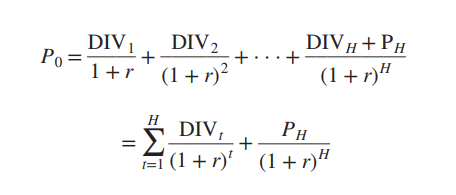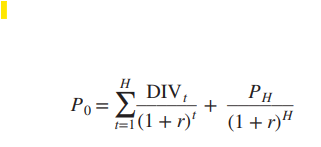Corporate Finance Ch4
1/39
There's no tags or description
Looks like no tags are added yet.
Name | Mastery | Learn | Test | Matching | Spaced |
|---|
No study sessions yet.
40 Terms
market cap(italization)
number of outstanding shares * closing price
Earnings per share
net income after taxes, interest, etc. / #of shares held by investors
dividend yield
dividend / stock price
ETF
exchange traded funds— a whole portfolio of stocks, not just one. S&P 500,Dow Jones
book value of equity
assets - liabilities
going-concern value
created when a collection of assets is organized into a healthy operating business
shortcomings of book value as a tool to measure market value
does not account for inflation
exclude intangible assets— IP
ignores going-concern value
liquidation value
what investors get when company fails and assets are sold.
2 approaches to valuing stocks
valuation by comparables (compare P/E and P/B)
forecast and then discountthe dividends or future cash flows
P/E
price to earnings ratio
P/B
Price to book ratio
how to estimate stock price with EPS and P/E
EPS * P/E
enterprise value
equity market cap + debt — the value of the firm to all debt and equity holders
EBIT vs. EBITDA
earnings before interest tax
earnings before interest depreciation amortization
how to estimate stock price using enterprise value
enterprise value - debt = market cap equity
then divide by outstanding shares
PV of a stock, known as dividend discount model
PV (price) = discounted cash flows ofall future dividends
reimann sum div / (1+r)^t
where t = infinity because stocks have no maturity
r = demanded rate of return
cost of equity
the r that investors demand of thestock.
expected return
expected returns = (Dividends + Price Sold - Price at investment) / price at investment
estimate todays P0 stock price based on forecast for one year
(dividend+price can sell) / (1+r)
risk class
all stocks of equivalent risk are priced to offer the same expected return
Find P0 using future prices and dividends until time H
if H goes to infinity, then remove the PH/(1+r)^H part of equation— it is 0

constant growth of dividends DCF model (growing perpetuity)
P0= DIV1 / (r-g)
dividend yield
DIV1/P0
plowback ratio
1- DIV/EPS
1-payout ratio
amount reinvested
ROE
EPS/book equity per share
Dividend Growth rate using plowback ratio and ROE
g=plowback ratio * ROE
plowback = 1- DIV/EPS
P0 DCF model with 2+ stages of growth

When to use perpetual growth formula vs. DCF with 2+ growth rates
if growth exceeds economy growth, it is not sustainable probably. that indicates growth will change and you should use DCF
or, if ROE appears to be increasing forever. it will not— it will reach a stable long term level
growth stocks
bought for capital gains, not dividends. longer term
income stocks
for shorter term and dividends
PVGO
net present value of growth opportunities
NPV of all investments the company is expected to make in the future
growth stocks have positive PVGO
how can we think of stock prices
value of average earnings under a no-growth policy + PVGO
P0 = EPS1/r + PVGO
Present Value of level stream of earnings
EPS1/r
PVGO
NPV1 / r-g
valuation based on free cash flows
wider picture, only concerned with what is available to be paid out to shareholders, not how its actually divided. FCF = earnings - new investment
FCF PV H
PV= reimann sum (FCFt)/(r+r)^t + PVh / (1+r)^h
remember, PVh is just price at time h
can estimate with P/E and P/B. then discount back when you plug into equation
does faster growth require increased investment?
yes. this reduces Free cash flow.
can ROA continue above the discount rate forever?
no,at some point you will be maintaining your profits, no longer growing.
at PV horizon, should PVGO = 0?
yes. PV horizon = earnings horizon + 1 /r